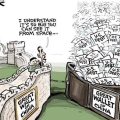Gold’s’ recent upward momentum has been thwarted for now, writes David Levenstein, arguing that further sideways but volatile action in the gold market should be expected in the short-term.
Author: David Levenstein
Posted: Tuesday , 15 Oct 2013
JOHANNESBURG –
After bouncing off three-month lows on Monday, gold prices have dipped today, giving back a small part of the prior session’s gains despite the persistent cloud of uncertainty that has settled over Washington.
Over the weekend, the president of the World Bank, Jim Yong Kim, warned the United States was just “days away” from causing a global economic disaster unless politicians come up with a plan to raise the nation’s debt limit and avoid default.
“We’re now five days away from a very dangerous moment. I urge U.S. policymakers to quickly come to a resolution before they reach the debt ceiling deadline…Inaction could result in interest rates rising, confidence falling and growth slowing,” World Bank President Jim Yong Kim said in a briefing following a meeting of the bank’s Development Committee.
“If this comes to pass, it could be a disastrous event for the developing world, and that will in turn greatly hurt developed economies as well,” he said.
Yet, despite the continuing political wrangling in Washington over the U.S. government shutdown and the debt ceiling, which one would expect to lower the value of the US dollar, the gold price has been under some selling pressure. And, last week the general sentiment toward gold was largely negative, with some investment banks like Goldman Sachs and Morgan Stanley issuing bearish views on gold’s outlook.
According to Jeffrey Currie head of commodities research at Goldman Sachs Group Inc.’s gold, is a “slam dunk” sell for next year because the U.S economy will extend its recovery after lawmakers resolve stalemates over the nation’s budget and debt ceiling.
The bank has a target for gold prices next year at $1,050 an ounce, Currie said last week in London. The precious metal has tumbled 21% this year to $1,322.28 an ounce on speculation that the US Federal Reserve would reduce its $85 billion monthly bond-buying program, known as quantitative easing, as the economy recovers. Lawmakers probably will reach an agreement on raising the debt ceiling before the Oct. 17 deadline, Currie said.
“Once we get past this stalemate in Washington, precious metals are a slam dunk sell at that point,” Currie said. “You have to argue that with significant recovery in the U.S., tapering of QE should put downward pressure on gold prices.”
Currie and Ric Deverell, the head of commodities research at Credit Suisse AG, both said on a panel at the Commodities Week conference in London that selling gold is their top recommendation for trading in raw materials in the next year.
I completely disagree. Even if the issue of the US debt ceiling is resolved, the fact remains that there is simply far too much debt in the global financial system. And, while bankers and politicians may be able to “kick the can down the road,” at some point, something has to give… and it is not going to be the price of gold!
The price of gold lost $25 in two minutes on Friday morning as “someone” decided to dump 800,000 ounces of notional gold into the London Fix (or COMEX open). In the space of 4 minutes, “someone” sold a whopping 2 million ounces of gold in one trade into the gold futures markets sending the price of gold to 3-month lows.
The order was so big, then, that gold was automatically halted in the middle of the order being filled.
The CME Group confirmed the halt. “We had what we call a stop logic event, which is a momentary pause in trading.” CME Group spokesman Chris Grams told CNBC.com. He noted that the halt started at 8:42:26 EDT, and trading resumed at 8:42:36. “All trades stand, and our technology performed as designed,” he said.
Usually, when a seller has a sizable amount to sell, he tries to get the best possible price by off-loading parts of the total quantity during a period of time. But, in an action which we are now fully accustomed to, when it comes to gold the seller is simply determined to manipulate prices by slamming the bid until there are no buyers left. It used to occur just before close of trading, an illegal practice known as “banging the close.” However, now it appears that much of this selling happens soon after the opening of Comex. Yet, the CFTC constantly turns a blind eye to this action.
While the CFTC deny that there is any manipulation of prices in the gold markets, there is enough evidence to the contrary. And, Friday’s action is simply another example of this on-going price suppression of gold prices. It is now becoming more evident that Western central banks and the U.S. government in particular — the Federal Reserve and Treasury Department are involved in this action as they remain determined to support the U.S. dollar and maintain the current global fiat currency system.
While the Fed does not intervene directly in the market, it operates through two primary ‘agent’ banks. These bullion banks in turn time naked short gold sales in the futures market to coordinate what the Fed is doing in the more opaque foreign exchange markets.
This sale of gold futures contracts creates an artificial supply of gold which will never be delivered. However, the quantity sold has the effect of pushing prices lower. This is exactly what the Fed wants especially when the US dollar comes under attack. The Fed then tries to create the illusion that gold prices are falling against a weaker dollar and thereby undermine investors’ confidence in the yellow metal. The reason for this is that gold remains a benchmark for the US dollar. If the dollar were to collapse, the prices of gold would surge. So, these bankers have to trick individuals around the world into believing that everything is just fine. What is even more outrageous is the measures these banks will go to in order to create this illusion. Recently, the Fed’s number one ‘agent bank,’ Goldman Sachs, was up to their old tricks again – advising clients to ‘sell gold.’ But, while they encourage clients to sell, I would not be surprised in the least if, in reality, what they are doing is looking to go long in gold and that they actually need fresh supply to come in to cover their short positions.
Meanwhile, many gold traders have opted to remain on the side-lines to avoid being caught in a volatile price move, while others said they expect this week’s weakness to continue, especially after Friday’s sell-off.
Global finance chiefs have criticised the U.S. for the political gridlock they identified as the biggest threat to the world’s economy and financial markets.
As these policy makers arrived in Washington for the annual meetings of the International Monetary Fund and World Bank, many expressed their concern that failure by U.S. lawmakers to end a government shutdown and raise the nation’s debt ceiling could trigger a default.
The lack of resolution would have “very negative consequences for the U.S. economy and spill-over effects which mean negative consequences for the rest of the world,” IMF Managing Director Christine Lagarde told Bloomberg Television in a recent interview on “Surveillance” with Tome Keene. “It could precipitate another crisis if it was to last longer.”
If the standoff persists “it is probably safe to say that this could cause severe damage to the U.S. economy and the world,” European Central Bank President Mario Draghi said. “The world still does not believe that the United States will not find a way out.
Both Lagarde and U.S. Treasury Secretary Jacob J. Lew warned that the political impasse could sap the safe-haven status of U.S. assets.
“The world actually counts on us being responsible,” Lew told the Senate Finance Committee, as he cautioned that the spat is “beginning to stress the financial markets.”
Lagarde said the U.S. should be wary that it is “not damaged because of what is going on” and also welcomed the proposal to buy more time.
A U.S. debt default in the event that a politically divided Congress fails to raise the federal borrowing limit would imperil the entire global economic recovery, a senior International Monetary Fund official warned Wednesday.
But Jose Vinals, the IMF’s financial counsellor, said he sees the actual risk of such a default as very low.
“It would be a worldwide shock,” Vinals told a Washington news conference, at which the IMF released its Global Financial Stability Report.
“This is something that would have very significant repercussions on financial markets around the world, not just on the United States,” Vinals said. “So let’s hope that we never get there.”
A report was released ahead of the IMF and World Bank’s annual meeting which began last week. The IMF said that the partial U.S. government shutdown, now in its second week, is adding to uncertainty about the still-fragile global economic recovery.
“While the damage to the U.S. economy from a short shutdown is likely to be limited, a longer shutdown could be quite harmful,” the report said. “And even more importantly, a failure to promptly raise the debt ceiling, leading to a U.S. selective default, could seriously damage the global economy and financial system.”
On Saturday, the president of the World Bank warned the United States was just “days away” from causing a global economic disaster unless politicians come up with a plan to raise the nation’s debt limit and avoid default.
“We’re now five days away from a very dangerous moment. I urge U.S. policymakers to quickly come to a resolution before they reach the debt ceiling deadline…Inaction could result in interest rates rising, confidence falling and growth slowing,” World Bank President Jim Yong Kim said in a briefing following a meeting of the bank’s Development Committee.
Premier Li Keqiang yesterday told Secretary of State John Kerry that China was paying “great attention” to the U.S. debt ceiling, the official Xinhua News Agency reported today. China is the largest foreign owner of U.S. Treasuries, with $1.28 trillion worth of them at the end of July.
“The market doesn’t like uncertainties,” Yi Gang, deputy governor of China’s central bank, said in Washington. “They watch this drama very closely.”
China is “naturally concerned about the developments in the U.S. fiscal cliff,” the Asian country’s vice finance minister Zhu Guangyao said in a statement.
If the U.S. fails to raise the debt ceiling, the government could run out of cash… Meaning China – and the rest of the world – won’t receive its interest payments.
“We hope the United States fully understands the lessons of history,” Zhu said, referring to the last government deadlock in 2011, which led, in part, to the U.S. losing its triple-A credit rating.
China isn’t the only country pressuring the U.S. to get its act together. Japan, the country’s second-largest creditor, is also worried the value of its $1 trillion investment in U.S. Treasuries could plummet if there is no agreement on the debt ceiling.
“The U.S. must avoid a situation where it cannot pay and it’s triple-A ranking plunges all of a sudden,” Japanese finance minister Taro Aso said at a press conference. “The U.S. must be fully aware that if that happens, the U.S. would fall into fiscal crisis.
The actions of US politicians have bolstered China’s resolve to lessen the world’s reliance on the dollar, according to current and former Chinese government advisers.
“You can’t hijack the global economy through political struggles. It’s not responsible,” says Yu Yongding, a member of the Chinese Academy of Social Sciences, a leading government think-tank.
“We are angry but are not panicked. The consequences are bad for the reputation of the US because the credibility of debt is so important,” says Mr Yu, who is also a former adviser to the central bank’s monetary policy committee.
“We need to continue to diversify. Even without this latest debt debate, it would still be necessary to diversify,” says Zhu Baoliang, an economist in the State Information Center, a research unit of the National Development and Reform Commission, a powerful planning agency.
As the storm clouds gathered over Washington on Thursday, Beijing made another small move to increase the international use of the renminbi, signing a swap agreement with the European Central Bank.
Now that Janet Yellen has been named to lead the Federal Reserve the global financial markets should factor out any possibility that the Fed will diminish their Quantitative easing program anytime soon. In fact, there is a good chance that the QE program is more likely to be perpetuated and expanded.
While there are investors stupid enough to believe that debt issued by the world’s largest debtor country (i.e. US Treasuries) should be treated as a risk-free asset they are obviously not concerned about the value of money. Yes, the Fed can expand its balance sheet indefinitely beyond the $3 trillion they have already conjured out of nowhere. The world need not fear a shortage of dollars.
But in real terms, that’s precisely the point. The Fed can control the supply of dollars, but it cannot control their value on the foreign exchanges.
Until, fiscal and monetary discipline and sanity returns to the US and the world, gold will continue to be bought by prudent individuals in order to hedge the continuing debasement of paper currencies.
Personally, I am certain that some type of cosmetic deal will be reached soon and it will be back to business as usual. The U.S. Debt Ceiling will be raised once again. It will be the 18th raise in the debt limit in 20 years. Raising the limit will happen and continuing imprudent fiscal and monetary policies in the U.S. are likely to lead to higher interest rates which will have dire consequences for the U.S. economy and indeed the global economy.
Another increase in the debt ceiling will allow U.S. politicians to continue spending which will lead to a further loss in confidence as well as the value of the U.S. dollar. And, as this happens the price of gold will go much higher. While politicians continue to bankrupt nations and steal from individuals, I recommend that you own some physical gold and silver.
TECHNICAL ANALYSIS

Gold’s’ recent upward momentum has been thwarted for now, and I expect to see more sideways but volatile action in the short-term.
About the author
David Levenstein began trading silver through the LME in 1980, over the years he has dealt with gold, silver, platinum and palladium. He has traded and invested in bullion, bullion coins, mining shares, exchange traded funds, as well as futures for his personal account as well as for clients.For more information go to: www.lakeshoretrading.co.za
Information contained herein has been obtained from sources believed to be reliable, but there is no guarantee as to completeness or accuracy. Any opinions expressed herein are statements of our judgment as of this date and are subject to change without notice.
Source: Mineweb






